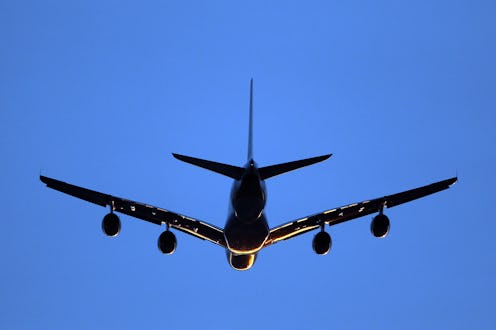News
Mid Air Plane Crashes Are Actually Very Rare
Less than two months after the TransAsia Airways crash, the Germanwings Flight 4U 9525 crash has refocused the spotlight back on the troubled aviation industry, which has seen seven major commercial flight incidents in the past 13 months. Part of what made these accidents so high-profile were the baffling, anomalous circumstances surrounding them, like the complete disappearance of Flight MH370 and the shooting down of MH17 just four months later. But there's another atypical detail that is far less reported: most of these crashes stem from a mid air incident, which is peculiar because the vast majority of plane crashes occur during takeoff or landing.
According to a Huffington Post blog post by Ben Sherwood, author of The Survivors Club: The Secrets and Science that Could Save Your Life, roughly 80 percent of airplane accidents occur during the first three minutes and last eight minutes of a flight, aka during takeoff or landing. In fact, that's what happened with TransAsia Airways Flight 235, which went down shortly after takeoff after the pilots reported an engine flameout, which is when the engine loses power and shuts off.
According to 1001crash.com, a website that tracks airplane accidents and statistics, when crashes occur during the takeoff phase, it's because any defects the plane might have usually manifest shortly after it starts to climb. Likewise, retired U.S. Airways captain John Cox told USA Today that accidents are also more likely to occur during the final descent because it requires more procedures and maneuvering, placing the aircraft in a more vulnerable position.
Given this information, the major crashes in the past year become even more pronounced; the majority of them stemmed from something that occurred mid air, not during takeoff or landing.
Flight MH370
On March 8, 2014, Malaysia Airlines Flight 370 was on its way to Beijing, China, from Kuala Lumpur, Malaysia, when it disappeared from radar over the South China Sea about an hour after takeoff.
Malaysia military radar continued to track it as it deviated from its flight path before disappearing completely. The timing of when the aircraft lost contact and went off radar suggests that something happened when the plane was cruising, after it had taken off and before its intended descent.
Flight MH17
While the fate of Malaysia Airlines Flight 17 is less mysterious, it's no less tragic. On July 17, 2014, the Boeing 777 carrying 283 passengers and 15 crew members crashed after being shot with a surface-to-air missile by pro-Russian separatists.
Though the cause of death is certainly extreme, it's certainly not the first time a commercial flight was downed by sabotage. Some notable past examples include Pan Am Flight 103, which was downed by a terrorist bomb in 1988, and the four hijacked planes that were downed during the 9/11 attacks.
Air Algerie Flight 5017
Like MH370, Flight AH5017 also disappeared from radar about an hour after takeoff, during the cruising period. According to reports, the plane reached cruising altitude after 22 minutes and after that gradually began to lose speed and descend until it crashed.
Because the pilots had reported severe storms earlier, authorities have blamed the crash on weather conditions. The wreckage was later found in Mali.
AirAsia Flight 8501
While Singapore-bound AirAsia Flight 8501 did experience an unusual takeoff from Surabaya, Indonesia, it ultimately disappeared during cruising. Indonesian officials confirmed that the plane had ascended at an abnormally high speed, likely because it was caught in strong winds, before stalling and crashing.
Shortly after the pilots requested to deviate from their planned path, air traffic control lost contact with the plane.
Germanwings Flight 9525
Though details are still emerging, Germanwings confirmed that Flight 4U9525 had reached its cruising altitude immediately before starting an inexplicable descent, which continued for about eight minutes before air traffic control lost contact with the plane. (UPDATE: New reports indicate the descent lasted for 18 minutes.) Germanwings' Managing Director Thomas Winkelmann said at a news conference:
The aircraft's contact with French radar, French air traffic controllers, ended at 10:53 a.m. at an altitude of about 6,000 feet. The plane then crashed.
The plane had been flying for about an hour.
Images: Getty Images (6)
